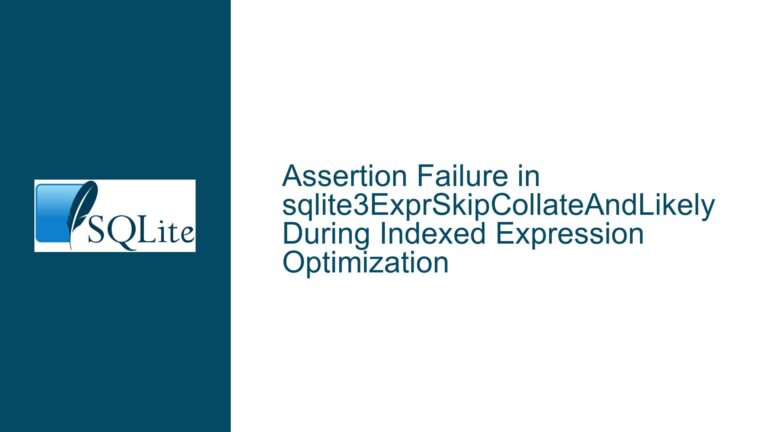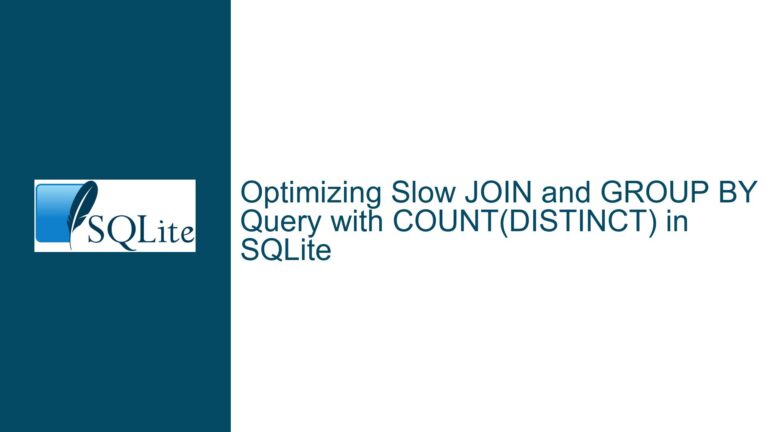Performance Degradation in SQLite 1.0.113 Due to Environment Variable Access
Performance Degradation During Connection Open in SQLite 1.0.113
The performance degradation observed in SQLite version 1.0.113, particularly during the connection open operation, is a significant concern for users migrating from earlier versions such as 1.0.74. The primary issue stems from the introduction of new features that involve accessing environment variables and XML configuration files. These accesses occur within the constructors and are executed during the connection open phase, leading to a noticeable slowdown in overall database operations. The performance degradation is not limited to the connection open operation but also affects other operations such as insert, select, update, and delete. The following table illustrates the performance comparison between SQLite versions 1.0.74 and 1.0.113:
| Scenario | Version 1.0.74 | Version 1.0.113 |
|---|---|---|
| Open | 8ms | 25ms |
| Close | 2ms | 6ms |
| Insert | 10720ms | 27937ms |
| Flat Query | 20ms | 40ms |
| Update | 15ms | 35ms |
| Delete | 3768ms | 3598ms |
The table clearly shows that the time taken for each operation has increased significantly in version 1.0.113 compared to version 1.0.74. The connection open operation, in particular, has seen a threefold increase in execution time, which is a critical bottleneck for applications that rely on frequent database connections.
Configuration Reads and Environment Variable Access in Connection Open
The root cause of the performance degradation in SQLite 1.0.113 can be traced back to the introduction of configuration reads that access environment variables and XML files. These reads are executed within the constructors and are triggered during the connection open operation. The access to environment variables and XML files is a relatively expensive operation, especially when compared to the in-memory operations that were prevalent in earlier versions of SQLite. The repeated access to these external resources during the connection open phase introduces a significant overhead, leading to the observed performance degradation.
In addition to the environment variable and XML file access, the way connections are retrieved from the connection pool has also contributed to the slowdown. The connection retrieval process involves binary searches, which, although efficient in theory, introduce additional latency when executed repeatedly. The combination of these factors results in a compounded performance impact, affecting not only the connection open operation but also other database operations that depend on the connection.
Optimizing Environment Variable Access and Connection Pool Retrieval
To address the performance degradation in SQLite 1.0.113, several strategies can be employed to optimize the access to environment variables and improve the efficiency of connection pool retrieval. The following steps outline the recommended approach to mitigate the performance issues:
Minimizing Environment Variable and XML File Access
One of the most effective ways to reduce the performance overhead is to minimize the number of times environment variables and XML files are accessed during the connection open operation. This can be achieved by caching the configuration values in memory after the first access. By storing the configuration values in a cache, subsequent connection open operations can retrieve the values from memory instead of accessing the external resources repeatedly. This approach significantly reduces the latency associated with environment variable and XML file access.
Optimizing Connection Pool Retrieval
The binary search algorithm used for retrieving connections from the connection pool can be optimized to reduce the latency introduced by repeated searches. One approach is to implement a hash-based retrieval mechanism, where connections are indexed using a hash table. This allows for constant-time retrieval of connections, eliminating the need for binary searches. Additionally, the connection pool can be pre-initialized with a set of connections, reducing the time required to establish new connections during peak load.
Implementing Asynchronous Configuration Reads
Another approach to mitigate the performance impact of configuration reads is to implement asynchronous access to environment variables and XML files. By offloading the configuration reads to a separate thread, the main thread responsible for the connection open operation can proceed without waiting for the configuration values to be retrieved. This approach allows for parallel execution of the configuration reads and the connection open operation, reducing the overall latency.
Profiling and Benchmarking
To ensure that the optimizations are effective, it is essential to profile and benchmark the database operations after implementing the changes. Profiling tools can be used to identify any remaining bottlenecks in the connection open operation and other database operations. Benchmarking the performance against the previous version (1.0.74) can provide insights into the effectiveness of the optimizations and help identify any areas that require further improvement.
Database Configuration Tuning
In addition to the above strategies, tuning the database configuration parameters can also contribute to improved performance. For example, adjusting the size of the connection pool, optimizing the query cache, and configuring the journal mode can have a significant impact on the overall performance of the database. It is recommended to experiment with different configuration settings and monitor the performance to identify the optimal configuration for the specific use case.
Monitoring and Continuous Improvement
Finally, it is important to establish a monitoring system to track the performance of the database over time. Continuous monitoring allows for the early detection of any performance degradation and provides the opportunity to address issues before they become critical. Regularly reviewing the performance metrics and making incremental improvements based on the observed trends can help maintain the optimal performance of the database.
In conclusion, the performance degradation observed in SQLite 1.0.113 is primarily due to the increased access to environment variables and XML files during the connection open operation, as well as the inefficiencies in the connection pool retrieval process. By implementing the strategies outlined above, it is possible to mitigate the performance impact and achieve a level of performance comparable to earlier versions of SQLite. The key to success lies in a combination of caching, optimization, asynchronous execution, and continuous monitoring, ensuring that the database operates efficiently even under heavy load.






